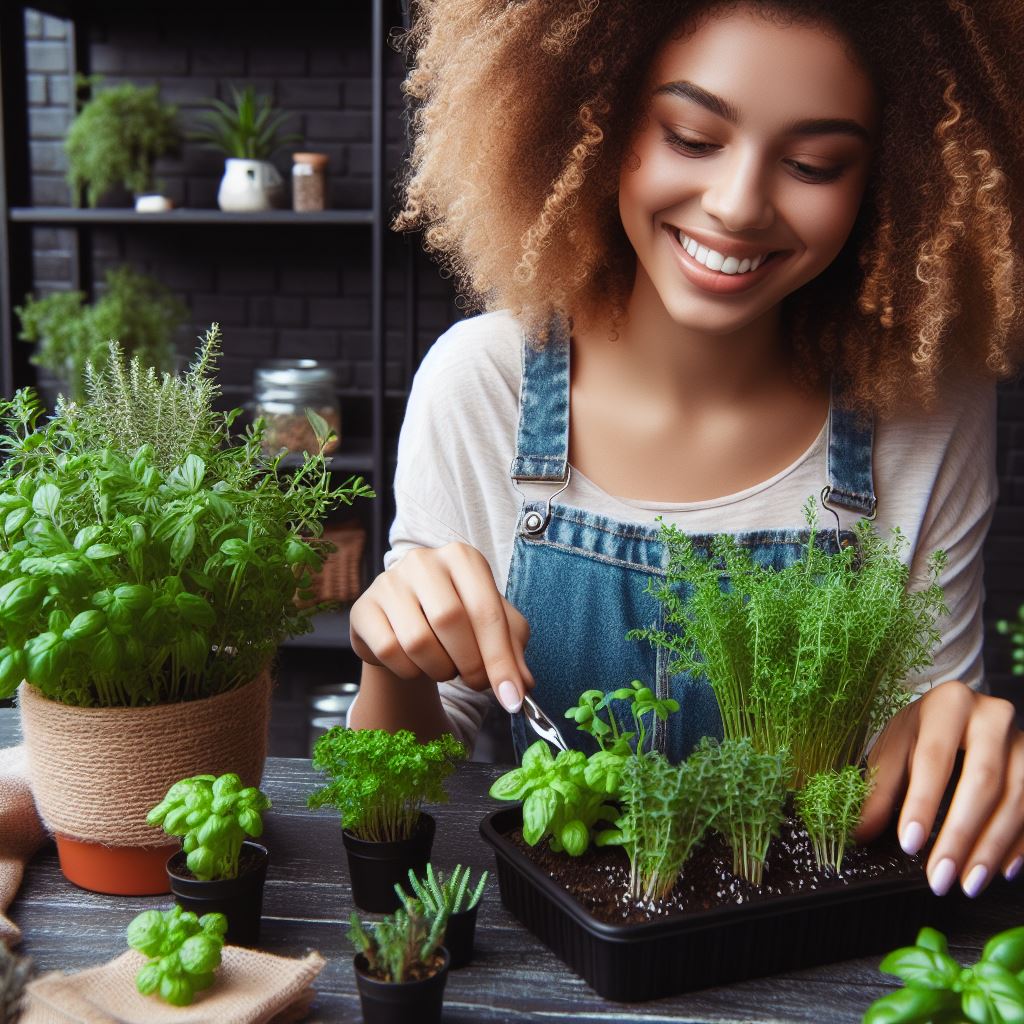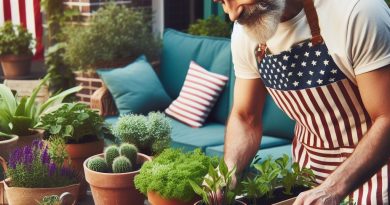Tiny Space, Huge Taste: Easy-to-Grow Herbs
Last Updated on March 2, 2024
Introduction
In recent years, home gardening has become increasingly popular, with more people embracing the joy of growing their own herbs.
Herbs play a crucial role in cooking, adding flavor, aroma, and nutritional value to dishes.
Growing herbs at home ensures freshness and accessibility.
The Ease of Growing Herbs
- Herbs are ideal for small spaces as they can thrive in containers, windowsills, or even hanging baskets.
- Beginner gardeners can easily cultivate herbs like basil, mint, and parsley, as they require minimal care and attention.
- Growing herbs at home allows you to control the quality of the soil, ensuring organic and pesticide-free options.
- With the right amount of sunlight, water, and occasional pruning, herbs can flourish in any tiny space.
Benefits of Homegrown Herbs
- The convenience of having fresh herbs at your fingertips eliminates the need to make frequent trips to the grocery store.
- Homegrown herbs are more flavorful and aromatic than store-bought options, enhancing the taste of your favorite dishes.
- Harvesting herbs from your own garden provides a sense of satisfaction and connection to nature.
- Using homegrown herbs promotes sustainability by reducing packaging waste and minimizing transportation carbon footprint.
Creative Ways to Use Herbs
- Experimenting with different herb combinations can take your cooking to a whole new level.
- Infusing herbs in oils, vinegars, or alcohol creates unique and flavorful bases for dressings, marinades, and cocktails.
- Adding herbs to homemade teas or desserts adds a refreshing twist and boosts the overall sensory experience.
- Herbs can also be dried or frozen for future use, ensuring a year-round supply of aromatic flavors.
Home gardening offers the opportunity to enjoy an abundance of fresh and flavorful herbs, even in the tiniest of spaces.
By taking up this easy and rewarding practice, you can elevate your culinary adventures and embrace the benefits of nature’s bounty.
The Advantages of Growing Herbs in Tiny Spaces
Limited Space in Urban Dwellings
- Urban dwellers often face the challenge of limited space for gardening.
- High-rise apartments and small balconies leave little room for traditional gardens.
- However, this should not discourage individuals from enjoying fresh herbs at their fingertips.
- By utilizing tiny spaces effectively, one can still experience the joys of growing herbs.
- Even a small container or vertical gardening setup can be a game-changer.
Suitability of Herbs for Small Containers or Vertical Gardening
- Herbs are highly suitable for small containers or vertical gardening due to their compact size.
- Many herbs have shallow root systems, making them perfect for small pots or hanging baskets.
- This adaptability allows herb enthusiasts to maximize their available space.
- Vertical gardening systems also provide a unique and trendy way to grow a variety of herbs.
- By utilizing walls or trellises, herbs can be grown vertically, saving precious floor space.
Low Maintenance and Minimal Space Requirements
- Another advantage of growing herbs in tiny spaces is their low maintenance nature.
- Herbs are typically easy to grow and require minimal care, making them perfect for busy urban dwellers.
- Most herbs thrive in well-drained soil and do not require extensive watering.
- Furthermore, herbs are generally resistant to pests and diseases, reducing the need for chemical interventions.
- The minimal space requirements of herbs make them ideal for even the tiniest of living spaces.
Generally, growing herbs in tiny spaces offers numerous advantages for urban dwellers.
Despite limited space, individuals can still enjoy the benefits of fresh herbs right at home.
Whether it is utilizing small containers or exploring vertical gardening techniques, there are endless possibilities.
Herbs’ adaptability, low maintenance nature, and minimal space requirements make them the perfect choice for tiny gardens.
So don’t let the constraints of urban living hold you back from experiencing the joy of growing your own herbs!
Read: Kitchen Garden: Hydroponics for Beginners
Easy-to-Grow Herbs for Tiny Spaces
Here are the top five herbs for small gardens or indoor pots:
Basil – versatile and abundant
Basil is a must-have for any herb garden or indoor pot.
Its fresh, fragrant leaves are perfect for enhancing the flavor of various dishes.
You can use basil in Italian recipes, such as pasta sauces, pizzas, and salads.
It also pairs well with tomatoes and mozzarella cheese.
Basil is easy to grow and thrives in containers or small spaces.
Parsley – resilient and versatile
Parsley is an excellent choice for tiny spaces due to its ability to adapt and grow in various conditions.
It is a biennial herb that adds a fresh and vibrant taste to your dishes.
You can use parsley to garnish salads, soups, and stews.
It also complements fish, poultry, and lamb.
Parsley is rich in vitamins and minerals, making it a healthy addition to your meals.
Mint – aromatic and invigorating
If you’re looking for a herb that can transform your beverages and desserts, mint is the perfect choice.
Its refreshing aroma and cool taste make it an excellent addition to cocktails, teas, and fruit salads.
Mint is also known for its digestive properties, making it a popular choice for herbal teas.
This herb is low-maintenance and grows well in pots or hanging baskets.
Chives – simple and flavorful
Chives are a versatile herb that adds a mild onion flavor to your dishes.
They are easy to grow and require minimal space.
Chives are commonly used in salads, omelets, and creamy sauces.
They are also great for garnishing baked potatoes or adding a pop of color to your garden.
Chives belong to the onion family and are rich in antioxidants and vitamins.
Thyme – compact and fragrant
Thyme is a compact herb that can easily thrive in small gardens or pots.
Its aromatic leaves have a unique flavor that enhances the taste of various dishes, such as roasted meats, grilled vegetables, and sauces.
Thyme also pairs well with other herbs like rosemary and sage.
It is a hardy herb that can withstand dry conditions and requires minimal maintenance.
Essentially, when it comes to growing herbs in tiny spaces, these five options stand out due to their adaptability and flavorful qualities.
Whether you have a small garden or limited indoor space, basil, parsley, mint, chives, and thyme are great choices that can enhance the taste of your meals.
With their easy cultivation and impressive versatility, you’ll be able to enjoy the benefits of fresh herbs even in the smallest of spaces.
Read: Urban Veggie Gardens: Small Spaces, Big Yields
Essential Tips for Growing Herbs in Limited Spaces
General guidelines on soil, sunlight, and watering requirements
- Choose a well-draining soil mix specifically formulated for container gardening to ensure proper water retention.
- Place your herb garden in a spot that receives at least six hours of direct sunlight daily.
- Water your herbs regularly, keeping the soil moist but not saturated, as herbs usually prefer slightly dry conditions.
- Avoid overwatering by checking the soil moisture level with your finger before watering.
- Mulch the top layer of soil to conserve moisture and prevent weed growth.
Suitable containers or vertical gardening setups
- Opt for compact containers such as pots or window boxes that fit well in limited spaces.
- Consider using hanging planters or wall-mounted herb gardens to maximize vertical space.
- Choose containers with good drainage holes to prevent waterlogging and root rot.
- Use recycled materials like old buckets, tin cans, or wooden crates for a creative and budget-friendly approach.
- Ensure the chosen containers are large enough to accommodate proper root growth for healthy herbs.
Importance of pruning or pinching to maintain compact growth
- Regularly prune or pinch the tips of your herbs to encourage bushier growth and prevent legginess.
- Pinching involves gently squeezing the top growth between your thumb and forefinger to remove a portion of the stem.
- Pruning involves using clean and sharp pruning shears to cut back the excessive growth.
- Removing flower buds frequently helps channel more energy into foliage production, resulting in more flavorful herbs.
- Pruning also helps maintain the overall size and shape of the herbs, making them more suitable for limited spaces.
In general, growing herbs in limited spaces is definitely achievable with the right techniques and considerations.
By providing general guidelines on soil, sunlight, and watering requirements, one can ensure the herbs thrive in their confined environment.
Suggesting suitable containers or vertical gardening setups allows for maximum utilization of space.
Additionally, highlighting the importance of pruning or pinching highlights the need to maintain compact growth.
With these essential tips in mind, anyone can enjoy fresh herbs right from their own tiny space, without compromising on taste or quality.
Read: Grow Herbs on Your Porch: Simple Techniques

Creative Ideas for Displaying Tiny Herb Gardens
Utilizing Unconventional Containers
- Repurpose mason jars for a charming and rustic look that can be hung or placed on a windowsill.
- Hang a shoe organizer on a wall or fence and fill each pocket with different herb plants.
- Use vintage teacups or tea tins as unique containers for individual herbs.
Enhancing the Aesthetic Appeal of Small Spaces
- Create a tiered herb garden using wooden crates or shelves, displaying different herbs on each level.
- Paint small pots in bright colors and arrange them in a pattern for a vibrant and eye-catching herb garden.
- Incorporate succulents or flowers alongside your herbs to add variety and visual interest to your small garden.
Incorporating Herbs into Balcony Gardens or Kitchen Window Shelves
- Hang a vertical planter on your balcony railing or attach it to the wall to maximize space for herb plants.
- Place a small herb garden on your kitchen window shelf, allowing easy access to fresh herbs while cooking.
- Use hanging baskets or planters to create a cascading herb garden on your balcony or near your kitchen window.
Utilizing Unconventional Containers
Herbs not only provide flavor and fragrance to dishes, but they can also be aesthetically pleasing in small spaces.
By utilizing unconventional containers like repurposed mason jars or hanging shoe organizers, you can create a unique and charming herb garden.
Hanging the herb garden on a windowsill or balcony railing can also help save space.
Enhancing the Aesthetic Appeal of Small Spaces
In addition to utilizing unconventional containers, herbs have the potential to enhance the visual appeal of small spaces.
Creating a tiered herb garden with wooden crates or shelves not only adds functionality but also adds a beautiful focal point.
Painting small pots in vibrant colors or incorporating other plants like succulents or flowers can further elevate the aesthetic appeal of your herb garden.
Incorporating Herbs into Balcony Gardens or Kitchen Window Shelves
If you have a small balcony or limited counter space, incorporating herbs can still be possible.
Hanging a vertical planter or using hanging baskets can maximize the use of space while creating a stunning herb display.
Placing a herb garden on your kitchen window shelf allows easy access to fresh herbs while cooking.
In essence, you don’t need a large garden to grow herbs.
With creative ideas for displaying tiny herb gardens, you can utilize unconventional containers, enhance the aesthetic appeal of small spaces, and incorporate herbs into balcony gardens or kitchen window shelves.
So start growing your own herbs today and enjoy the fresh flavors and beautiful sights they bring to your home.
Read: Easy Herbs for Window Gardening Success
Gain More Insights: Organic Solutions to Common Plant Diseases
Harvesting and Using Fresh Herbs
The best time to harvest different types of herbs
- Basil should be harvested just before it starts to flower for the best flavor.
- Chives can be cut at any time, but the flavor is strongest when they are in bloom.
- Cilantro should be harvested before it bolts, as the leaves become bitter afterwards.
- Dill should be harvested when the main stem reaches about 12 inches tall.
- Mint leaves can be harvested at any time during the growing season.
- Oregano is best harvested just before the flowers open for the most intense flavor.
- Parsley leaves can be cut whenever needed, but avoid harvesting the entire plant at once.
- Rosemary leaves can be harvested at any time, but the flavor is most intense just before flowering.
- Sage should be harvested before it flowers for the best flavor.
- Thyme can be harvested at any time, but the leaves are most flavorful just before flowering.
Proper techniques for storing and preserving fresh herbs
- After harvesting, gently rinse the herbs under cold water to remove any dirt or insects.
- Pat the herbs dry with paper towels or a clean kitchen towel to remove excess moisture.
- For short-term storage, wrap the herbs loosely in damp paper towels and place them in a plastic bag.
- Store the bag in the refrigerator’s crisper drawer to keep the herbs fresh for up to a week.
- Alternatively, you can store herbs in a glass of water, similar to a bouquet of flowers.
- For long-term storage, drying is the best method. Bundle the herbs and hang them upside down in a dark, well-ventilated area.
- Once completely dried, crumble the herbs and store them in airtight containers in a cool, dark place.
- Another method for preserving fresh herbs is freezing. Chop the herbs and place them in ice cube trays.
- Fill the trays with water or oil and freeze them. Pop out the herb cubes and store them in a freezer-safe bag or container.
- When using frozen herbs, add them directly to soups, stews, and sauces without thawing.
Ideas for using freshly harvested herbs in cooking, teas, or homemade remedies
- Add freshly harvested basil to homemade tomato sauce for a burst of flavor.
- Sprinkle chives on top of scrambled eggs or potatoes for a hint of oniony goodness.
- Infuse freshly harvested cilantro in water for a refreshing and detoxifying drink.
- Use dill to season roasted potatoes, cucumber salads, or homemade pickles.
- Brew mint leaves in hot water for a soothing and minty tea.
- Add oregano to pasta sauces, pizza, or marinades for a Mediterranean twist.
- Chop fresh parsley and sprinkle it over grilled meats or roasted vegetables for added freshness.
- Incorporate rosemary into roasted chicken, grilled lamb, or homemade bread.
- Brew sage leaves in boiling water to make a calming and aromatic tea.
- Sprinkle fresh thyme over roasted vegetables, grilled fish, or soups for a savory touch.
By harvesting herbs at the right time and using proper storage techniques, you can enjoy the full flavor and benefits of these easy-to-grow plants in your cooking, teas, and homemade remedies.
Experiment with different herbs and discover the endless possibilities they bring to your culinary creations.
Troubleshooting Common Herb Garden Problems
Common Issues in Herb Gardens
- Pests: Aphids, slugs, and snails can attack herb plants, causing damage to leaves and stems.
- Diseases: Fungal infections like powdery mildew and root rot can affect the health of herbs.
Simple Solutions and Preventive Measures
Pests
- Introduce beneficial insects like ladybugs and lacewings that feed on aphids.
- Use organic pest control methods, like neem oil or insecticidal soaps, to eliminate pests.
- Create physical barriers like copper tape or eggshells to deter slugs and snails.
Diseases
- Ensure proper spacing between herb plants to allow good air circulation, reducing the chances of fungal infections.
- Avoid overhead watering and water herbs at their base to prevent splashing water onto leaves, which can lead to fungal growth.
- Remove infected leaves or plants immediately to prevent the spread of diseases.
Additional Tips to Maintain a Healthy Herb Garden
- Regularly inspect your herb plants for any signs of pests or diseases. Early detection is key to preventing their spread.
- Rotate herb planting locations each season to reduce the risk of diseases that may persist in the soil.
- Maintaining healthy soil is crucial. Add compost or organic matter to improve soil fertility and drainage.
- Overwatering can lead to root rot, so water herbs only when the top inch of soil feels dry.
- Prune herbs regularly to promote bushier growth and discourage overcrowding, which can create favorable conditions for disease development.
- Use clean gardening tools to prevent the transfer of diseases from one plant to another.
- Choose disease-resistant herb varieties whenever possible to minimize the risk of infections.
Common Issues in Herb Gardens
Troubleshooting common problems in your herb garden is essential to maintain healthy and productive plants.
By identifying and addressing pests and diseases promptly, you can prevent their spread and ensure a thriving herb garden.
Remember to regularly inspect your plants for any signs of trouble and take necessary preventive measures.
Pests like aphids, slugs, and snails can be controlled using organic pest control methods or by introducing beneficial insects.
Physical barriers like copper tape or eggshells can also deter slugs and snails.
On the other hand, diseases such as powdery mildew and root rot can be minimized by maintaining good air circulation, avoiding overhead watering, and removing infected leaves or plants immediately.
Additional Tips to Maintain a Healthy Herb Garden
In addition to troubleshooting specific problems, certain general practices will help maintain a healthy herb garden.
Regularly rotating planting locations, maintaining healthy soil, and proper pruning are all preventive measures that promote plant health and disease resistance.
Remember to water your herbs correctly, ensuring that you do not overwater, as this can lead to root rot.
Pruning herbs regularly will encourage bushier growth and reduce overcrowding, preventing conditions favorable for disease development.
Using clean gardening tools and selecting disease-resistant herb varieties will further reduce the risk of infections.
By following these simple solutions and preventive measures, you can enjoy a thriving herb garden all year round.
Keep a close eye on your plants, stay proactive, and address any issues promptly to ensure your tiny space continues to yield huge taste.
Happy herb gardening!
Conclusion
Growing delicious herbs no longer requires a sprawling backyard.
Even the most compact spaces can blossom with vibrant greenery, offering a host of advantages.
Imagine harvesting fresh, flavorful herbs for every culinary creation, right from your windowsill.
These miniature gardens require minimal space, care, and resources, making them perfect for busy lifestyles and tiny apartments.
So, don’t let limited space deter you from cultivating your own herb haven.
Embrace the possibilities, unleash your inner gardener, and embark on a rewarding journey of flavor and sustainability.
Get ready to experience the “huge taste” that tiny herb gardens bring!


